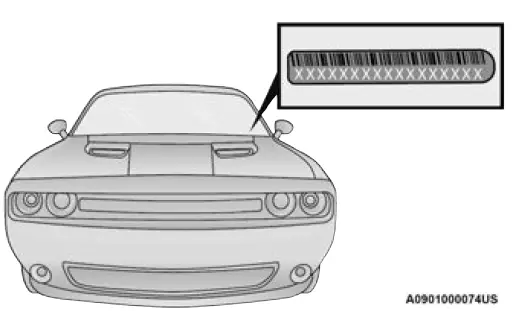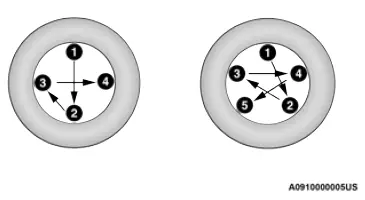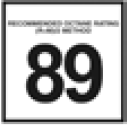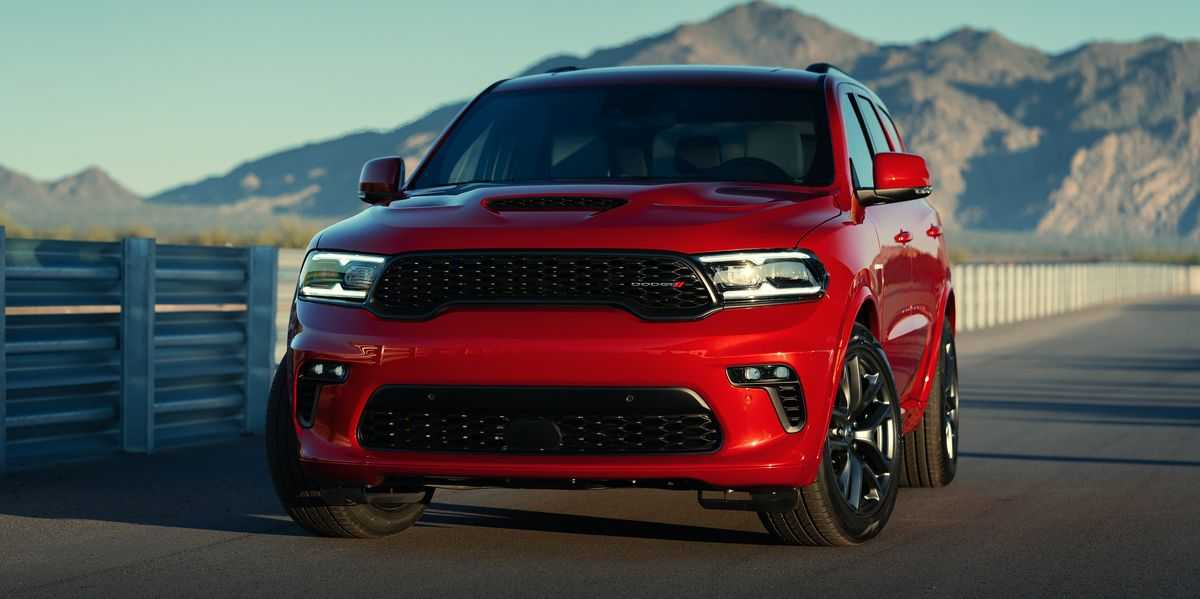Dodge Durango 2022 Technical Specifications User Manual
VEHICLE IDENTIFICATION NUMBER (VIN)
The VIN is on the left front corner of the instrument panel. The VIN is visible from outside of the vehicle through the windshield.

Windshield VIN Location
NOTE:
It is illegal to remove or alter the VIN.
BRAKE SYSTEM
Your vehicle is equipped with dual hydraulic brake systems. If either of the two hydraulic systems loses normal capability, the remaining system will still function. There will be some loss of overall braking effectiveness. This may be evident by increased pedal travel during application, greater pedal force required to slow or stop, and potential activation of the Brake Warning Light.
In the event power assist is lost for any reason (for example, repeated brake applications with the engine off), the brakes will still function. The effort required to brake the vehicle will be much greater than that required with the power system operating.
WHEEL AND TIRE TORQUE SPECIFICATIONS
Proper lug nut/bolt torque is very important to ensure that the wheel is properly mounted to the vehicle. Any time a wheel has been removed and reinstalled on the vehicle, the lug nuts/bolts should be torqued using a properly calibrated torque wrench using a six sided (hex) deep wall socket.
TORQUE SPECIFICATIONS
| Lug Nut/Bolt Torque | **Lug Nut/ Bolt Size | Lug Nut/Bolt Socket Size |
| 130 Ft-Lb (176 N·m) |
M14 x 1.50 | 22 mm |
**Use only authorized dealer recommended lug nuts/bolts and clean or remove any dirt or oil before tightening.
Inspect the wheel mounting surface prior to mounting the tire and remove any corrosion or loose particles.

Wheel Mounting Surface
Tighten the lug nuts/bolts in a star pattern until each nut/bolt has been tightened twice. Ensure that the socket is fully engaged on the lug nut/bolt (do not insert it halfway).
NOTE:
If in doubt about the correct tightness, have them checked with a torque wrench by an authorized dealer or service station.
After 25 miles (40 km), check the lug nut/bolt torque to be sure that all the lug nuts/bolts are properly tightened.

Torque Patterns
WARNING!
To avoid the risk of forcing the vehicle off the jack, do not tighten the lug nuts/bolts fully until the vehicle has been lowered. Failure to follow this warning may result in personal injury.
FUEL REQUIREMENTS
While operating on gasoline with the required octane number, hearing a light knocking sound from the engine is not a cause for concern. However, if the engine is heard making a heavy knocking sound, see a dealer immediately. Use of gasoline with a lower than recommended octane number can cause engine failure and may void the New Vehicle Limited Warranty.
Poor quality gasoline can cause problems such as hard starting, stalling, and hesitations. If you experience these symptoms, try another brand of gasoline before considering service for the vehicle.
3.6L ENGINE
Do not use E-85 flex fuel or ethanol blends greater than 15% in this engine.
 This engine is designed to meet all emission regulations and provide excellent fuel economy and performance when using high-quality unleaded regular gasoline having an octane rating of 87 as specified by the (R+M)/2 method. The use of higher octane premium gasoline will not provide any benefit over regular gasoline in these engines.
This engine is designed to meet all emission regulations and provide excellent fuel economy and performance when using high-quality unleaded regular gasoline having an octane rating of 87 as specified by the (R+M)/2 method. The use of higher octane premium gasoline will not provide any benefit over regular gasoline in these engines.
5.7L ENGINE
(WITH AUTOMATIC TRANSMISSION)
Do not use E-85 flex fuel or ethanol blends greater than 15% in this engine.
 This engine is designed to meet all emissions regulations and provide satisfactory fuel economy and performance when using high-quality 2 method. The use of 89 octane plus gasoline is recommended for optimum performance and fuel economy.
This engine is designed to meet all emissions regulations and provide satisfactory fuel economy and performance when using high-quality 2 method. The use of 89 octane plus gasoline is recommended for optimum performance and fuel economy.
unleaded gasoline having an octane range of 87 to 89 as specified by the (R+M)/2 method. The use of 89 octane plus gasoline is recommended for optimum performance and fuel economy.
REFORMULATED GASOLINE
Many areas of the country require the use of cleaner burning gasoline referred to as
“reformulated gasoline”. Reformulated gasoline contains oxygenates and are specifically blended to reduce vehicle emissions and improve air quality.
The use of reformulated gasoline is recommended. Properly blended reformulated gasoline will provide improved performance and durability of engine and fuel system components.
MATERIALS ADDED TO FUEL
Besides using unleaded gasoline with the proper octane rating, gasolines that contain detergents, corrosion and stability additives are recommended. Using gasolines that have these additives will help improve fuel economy, reduce emissions, and maintain vehicle performance.
 Designated TOP TIER Detergent Gasoline contains a higher level of detergents to further aide in minimizing engine and fuel system deposits. When available, the usage of TOP TIER Detergent gasoline is recommended. Visit www.toptiergas.com for a list of TOP TIER Detergent Gasoline Retailers.
Designated TOP TIER Detergent Gasoline contains a higher level of detergents to further aide in minimizing engine and fuel system deposits. When available, the usage of TOP TIER Detergent gasoline is recommended. Visit www.toptiergas.com for a list of TOP TIER Detergent Gasoline Retailers.
Indiscriminate use of fuel system cleaning agents should be avoided. Many of these materials intended for gum and varnish removal may contain active solvents or similar ingredients. These can harm fuel system gasket and diaphragm materials.
GASOLINE/OXYGENATE BLENDS
Some fuel suppliers blend unleaded gasoline with oxygenates such as ethanol.
CAUTION!
DO NOT use E-85, gasoline containing methanol, or gasoline containing more than 15% ethanol (E-15). Use of these blends may result in starting and drivability problems, damage critical fuel system components, cause emissions to exceed the applicable standard, and/or cause the Malfunction Indicator Light to illuminate. Please observe pump labels as they should clearly communicate if a fuel contains greater than 15% ethanol (E-15).
Problems that result from using gasoline containing more than 15% ethanol (E-15) or gasoline containing methanol are not the responsibility of the manufacturer and may void or not be covered under New Vehicle Limited Warranty.
DO NOT USE E-85 IN NON-FLEX FUEL VEHICLES
Non-Flex Fuel Vehicles (FFV) are compatible with gasoline containing up to 15% ethanol (E-15). Use of gasoline with higher ethanol content may void the New Vehicle Limited Warranty.
If a Non-FFV vehicle is inadvertently fueled with E-85 fuel, the engine will have some or all of these symptoms:
- Operate in a lean mode.
- OBD II Malfunction Indicator Light on.
- Poor engine performance.
Poor cold start and cold drivability.
Increased risk for fuel system component corrosion.
CNG AND LP FUEL SYSTEM MODIFICATIONS
Modifications that allow the engine to run on Compressed Natural Gas (CNG) or Liquid Propane (LP) may result in damage to the engine, emissions, and fuel system components. Problems that result from running CNG or LP are not the responsibility of the manufacturer and may void or not be covered under the New Vehicle Limited Warranty.
METHYLCYCLOPENTADIENYL
MANGANESE TRICARBONYL (MMT) IN GASOLINE
MMT is a manganese-containing metallic additive that is blended into some gasoline to increase octane. Gasoline blended with MMT provides no performance advantage beyond gasoline of the same octane number without MMT. Gasoline blended with MMT reduces spark plug life and reduces emissions system performance in some vehicles.
The manufacturer recommends that gasoline without MMT be used in your vehicle. The MMT content of gasoline may not be indicated on the gasoline pump; therefore, you should ask your gasoline retailer whether the gasoline contains MMT. MMT is prohibited in Federal and California reformulated gasoline.
FUEL SYSTEM CAUTIONS
CAUTION!
Follow these guidelines to maintain your vehicle’s performance:
- The use of leaded gasoline is prohibited by Federal law. Using leaded gasoline can impair engine performance and damage the emissions control system.
An out-of-tune engine or certain fuel or ignition malfunctions can cause the catalytic converter to overheat. If you notice a pungent burning odor or some light smoke, your engine may be out of tune or malfunctioning and may require immediate service. Contact an authorized dealer for service assistance. - The use of fuel additives, which are now being sold as octane enhancers, is not recommended. Most of these products contain high concentrations of methanol. Fuel system damage or vehicle performance problems resulting from the use of such fuels or additives is not the responsibility of the manufacturer and may void or not be covered under the New Vehicle Limited Warranty.
NOTE:
Intentional tampering with the emissions control system can result in civil penalties being assessed against you.
FLUID CAPACITIES
| US | Metric | |
| Fuel (Approximate) | ||
| 3.6L and 5.7L Engines | 24.6 Gallons | 93 Liters |
| Engine Oil With Filter | ||
| 3.6L Engine | 6 Quarts | 5.6 Liters |
| 5.7L Engine | 7 Quarts | 6.6 Liters |
| Cooling System * | ||
| 3.6L Engine – Without Trailer Tow Package | 10.4 Quarts | 9.9 Liters |
| 3.6L Engine – With Trailer Tow Package | 11 Quarts | 10.4 Liters |
| 5.7L Engine – Without Trailer Tow Package | 15.4 Quarts | 14.6 Liters |
| 5.7L Engine – With Trailer Tow Package | 16 Quarts | 15.2 Liters |
ENGINE FLUIDS AND LUBRICANTS
| Component | Fluid, Lubricant, or Genuine Part |
| Engine Coolant | We recommend using Mopar® Antifreeze/Coolant 10 Year/150,000 Mile (240,000 km) Formula OAT (Organic Additive Technology) meeting the requirements of the manufacturer Material Standard MS.90032. |
| Engine Oil – 3.6L & 5.7L Engine | We recommend using Mopar® SAE 0W-20 Full Synthetic Engine Oil which meets the requirements of the manufacturer Material Standard MS-6395. Equivalent full synthetic SAE 0W-20 engine oil can be used but must have the API Starburst trademark page 262. |
| Component | Fluid, Lubricant, or Genuine Part |
| Engine Oil Filter | We recommend using a Mopar® Engine Oil Filter. If a Mopar® Engine Oil Filter is unavailable only use filters that meet or exceed SAE/USCAR-36 Filter Performance Requirements. |
| Fuel Selection – 3.6L Engine | 87 Octane (R+M)/2 Method , 0-15% Ethanol (Do not use E-85). |
| Fuel Selection – 5.7L Engine | 89 Octane Recommended – 87 Octane Acceptable (R+M)/2 Method, 0-15% Ethanol (Do not use E-85). |
-
CHASSIS FLUIDS AND LUBRICANTS
-
Component Fluid, Lubricant, or Genuine Part Automatic Transmission Use only Mopar® ZF 8 & 9 Speed ATF Automatic Transmission Fluid or equivalent. Failure to use the correct fluid may affect the function or performance of your transmission. Transfer Case We recommend using Mopar® ATF+4 Automatic Transmission Fluid. Axle Differential (Front-Rear) – Without Electronic Limited-Slip Differential (ELSD) We recommend using Mopar® GL-5 Synthetic Axle Lubricant SAE 75W-85. Axle Differential (Rear) – With Electronic Limited-Slip Differential (ELSD) We recommend using Mopar® GL-5 Synthetic Axle Lubricant SAE 75W-85 with integrated friction modifier. Brake Master Cylinder We recommend using Mopar® DOT 3 Brake Fluid, SAE J1703.
2023 DODGE DURANGO Specs, Price, Features, Mileage (Brochure)
Reference Link
View Full PDF: Dodge Durango 2022 User Manual | Auto User Guide
Download Link: Owner’s Manuals & User Guides | Dodge


